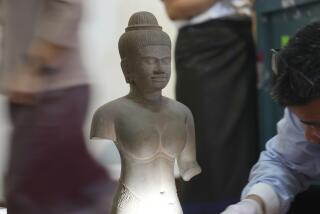After 25 Years of Restoration, Thailand Unveils Ancient Royal Capital of Sukhothai
- Share via
SUKHOTHAI, Thailand — Thailand, after 25 years of excavation and restoration, has unveiled one of Asia’s great Buddhist centers and an ancient royal capital from its “Golden Age.”
Peeling away centuries of jungle growth and soil, experts have partially restored 193 Buddhist temples, moats, kiln sites and other structures, which 700 years ago were part of the powerful city of Sukhothai.
These form the 27-square-mile Sukhothai Historical Park, which was formally opened this month, although the public has had access to the area for some time.
Officiating at the opening ceremonies was Princess Sirindhorn, a scholar of Thai culture and eldest daughter of King Bhumibol Adulyadej, the latest in a royal line that Thais regard as having begun in 1253 with the first king of Sukhothai.
$10-Million Renovation
The bid to save Sukhothai from destructive vegetation and thieves began in 1953 but stalled several years later. Work resumed in the mid-1960s and received a boost in 1978 when Thailand and the U.N. Educational, Scientific and Cultural Organization began a $10-million renovation plan.
Sukhothai was included in UNESCO’s campaign to restore 31 world cultural sites.
Its opening comes during heightened consciousness in Thailand about the theft of its art treasures. Earlier this month, the Art Institute of Chicago returned an ancient stone sculpture smuggled out of the country to the United States in the 1960s.
Decapitated statues and pilfered kiln sites at Sukhothai are testimony to the loss of heritage, but a leading Thai art historian, Prince Subhadradis Diskul, told reporters recently that what remains within the guarded, well-attended park should be secure.
Vulnerable to Plunderers
However, other Thai experts have expressed concern that outlying areas where archeological work is under way are vulnerable to antique hunters.
Although UNESCO provided valuable expertise, the overall restoration concept was worked out by Thais and involved the use of non-original materials to flesh out temples and even the addition of missing parts to giant statues of the Lord Buddha.
Although a more “purist” approach is normally preferred in the West, the Thais argued that the restoration should appeal to the general public as well as to the Buddhist faithful who don’t like to worship before headless images.
The Thai government--which avidly promotes tourism--also hopes that the restored monuments will attract more visitors. Officials say about 500,000 Thais and foreigners are expected to visit this year.
Danger to Natural Beauty
Some view the tourist boom as a danger to the tranquility and natural beauty of the area. In the past, guidelines and regulations on tourist development in Thailand have been violated by private entrepreneurs.
Beyond tourist revenue, officials say restoration of Sukhothai--which translates as “Dawn of Happiness”--is a national duty given the city’s central place in Thai history and culture.
The kingdom lasted less than 150 years but shaped many aspects of contemporary Thailand, including the Theravadda Buddhist religion. Thai script, notions of kingship and relatively egalitarian social relations were also developed.
At its height, the kingdom controlled an area stretching into modern-day Laos, Burma and Malaysia. Its artists and architects broke with the cultural dominance of Cambodia to create new styles, especially in depicting the Buddha in bronze images.
But internal strife eventually weakened Sukhothai, and power shifted to the south and the kingdom of Ayutthaya in 1378. The capital itself was abandoned in the 16th Century.
More to Read
Sign up for Essential California
The most important California stories and recommendations in your inbox every morning.
You may occasionally receive promotional content from the Los Angeles Times.













